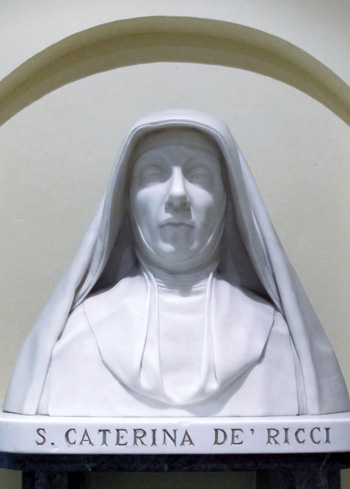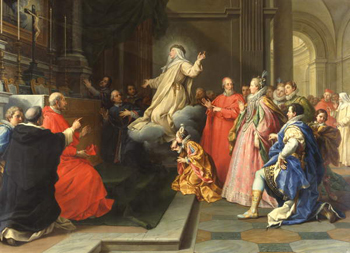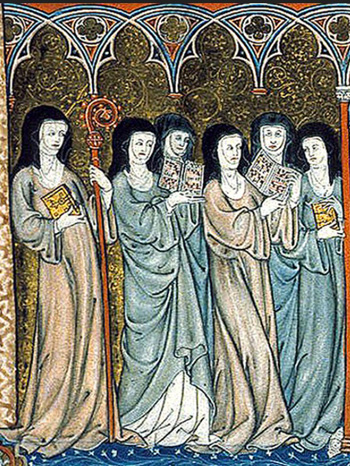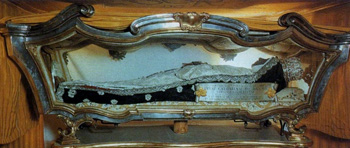Saints of the Day
 |
 |
 |
 |
 |
 |
 |
St. Catherine of Ricci - February 13
Biographical selection:
St. Catherine of Ricci belonged to a patrician family of Florence. She was born on April 23, 1522. At age 13 she entered the Convent of St. Vincent in Prato, Tuscany, a cloistered convent of the Third Order of St. Dominic.
 During her first years of convent life, she faced many problems: Her mysticism was misunderstood and she was considered mad. She was almost expelled. It was her heroic patience during two severe illnesses that opened the eyes of her companions.
During her first years of convent life, she faced many problems: Her mysticism was misunderstood and she was considered mad. She was almost expelled. It was her heroic patience during two severe illnesses that opened the eyes of her companions.
While still very young she became Master of Novices. At age 25 she was named Prioress, a position she held almost continuously until her death in February 1590.
From February of 1542, every Friday from 12 noon until 4 pm the next day, she experienced the Ecstasy of the Agony of Our Lord followed by the sufferings of His Passion. She experienced the stigmata, the wounds of the flagellation, crowning of thorns and carrying of the Cross were on her body.
Word spread about the phenomena and many persons would come to contemplate her. Many skeptics, indifferent souls, unbelievers and sinners converted after seeing her in those sufferings.
Her time was taken by persons in need or in sin who would come to ask her help, which caused the peace and strict observance of the Convent to suffer. Sometimes there were so many people that she would flee and hide.
She begged Heaven and asked the nuns to pray to God that He might cease these phenomena on her person so that the convent could return to peace. After 12 years of such sufferings, her prayers were heard.
A religious commented that the life in the convent was so blessed that if the world were aware of it, people would hasten to enter it.
St. Catherine of Ricci died surrounded by a choir of singing Angels, heard by all those present. Another mystic of the time, St. Madeleine of Pazzi, saw her ascending to Heaven amid a group of celestial spirits.
Comments of Dr. Plinio:
I believe that this selection is composed of two distinct parts. The first describe the virtues of the Saint; the second, her visions. Let us establish a clear distinction between the two.
 Virtues are the upright habits of a soul who practices good actions continuously and with rectitude. A religious woman, for example, who has the habit of chastity has her habitual state of chastity as the root of that virtue; the habit of poverty is rooted in her detachment from the earthly goods; her habit of obedience comes from her inner possession of obedience, of not doing her own will but rather the will of her superiors. Since she habitually has these dispositions of spirit, her external actions are customarily in concordance with them. She is invariably chaste, obedient and poor.
Virtues are the upright habits of a soul who practices good actions continuously and with rectitude. A religious woman, for example, who has the habit of chastity has her habitual state of chastity as the root of that virtue; the habit of poverty is rooted in her detachment from the earthly goods; her habit of obedience comes from her inner possession of obedience, of not doing her own will but rather the will of her superiors. Since she habitually has these dispositions of spirit, her external actions are customarily in concordance with them. She is invariably chaste, obedient and poor.
St. Catherine of Ricci's visions and the extraordinary phenomena are of another nature. They are exceptional graces that God gives to some souls for their own good and the good of others. God does not give these graces in a habitual way, but only to some saints.
Visions can be a manifestation of sanctity, but they do not necessarily mean the person has sanctity. Sanctity is expressed by one's behavior. The proof of this is that many Saints did not have visions or revelations, but their lives nonetheless revealed sanctity by the heroic conformity of their behavior to the precepts and counsels taught by Our Lord Jesus Christ. This is what reveals sanctity.
 So, what is sanctity? It is not only the possession of one good habit or all the good habits; it is rather the practice of heroic virtue. It is the practice of virtue in such way that the person needs heroism to do it. It is an outstanding way of possessing virtue. This is sanctity.
So, what is sanctity? It is not only the possession of one good habit or all the good habits; it is rather the practice of heroic virtue. It is the practice of virtue in such way that the person needs heroism to do it. It is an outstanding way of possessing virtue. This is sanctity.
So then, we have three concepts: virtue, heroic virtue, and visions and revelations. Virtue is accessible to all Catholics; heroic virtue requires special graces but all souls are called to practice it; visions and revelations are something different.
I have the impression that with the growing influence of Progressivism, you do not have an idea of the life of sacrifice and sublimity the religious state demands, even when it is practiced inside the four walls of a convent in the day-to-day actions of common life, not in extraordinary actions.
I sustain that when a soul lives inside a convent in common life, that soul can practice heroic virtue without performing extraordinary actions. I understand heroic here in the proper sense of the word: that is, it is a heroism equal to that demanded of a hero on the battlefield. This soul has the same sense of sacrifice and duty, the same immolation that a great hero can prove in the battle field. I sustain that this heroism is more authentic than many acts of heroism on the battlefield.
How can this affirmation be understood?
You understand that the most difficult thing for a man is to conquer his bad inclinations. Let us consider one of the vices that a man conquers with difficulty: laziness.
Laziness has its various forms: laziness to concentrate or pay attention to the spiritual, laziness of working continuously, laziness of thinking, laziness to conquer oneself when one should be humble, flexible and docile. Laziness is like an octopus that stretches its tentacles into every sphere of one's spiritual life. It is terribly difficult to combat laziness.
If you find a person who does not make concessions to laziness in anything, who does everything he should with perfection and does it without being moody or sad; rather he does everything joyfully because he is doing his duty and he is even disposed to do more if duty demands it; if you find someone like this you have found the rare case of an individual who has heroically conquered his own laziness.
 Now let us consider obedience. Perhaps you do not realize how difficult the life of a religious woman or man in a convent or monastery is. Here you have an adult man who, from morning to night, cannot do what he wants but has to do what he is told. Many times the commands are arbitrary and inconsistent.
Now let us consider obedience. Perhaps you do not realize how difficult the life of a religious woman or man in a convent or monastery is. Here you have an adult man who, from morning to night, cannot do what he wants but has to do what he is told. Many times the commands are arbitrary and inconsistent.
The superior says: "Brother X or Friar Y, it is time now to water the garden."
He looks outside and sees that it has rained so it is not necessary to water the garden. It is, however, necessary to obey. He goes and waters the garden.
"Brother X, you cleaned the floor poorly. Go and clean it again."
He replies: "Fr. Superior, could you show me where the floor is poorly cleaned?"
The Superior replied: "Let us go together and I will show you." Reaching the place, the Superior points to a corner and say: "Look here, the floor is dirty."
But the floor is actually clean. The brother has to clean it again to learn how to obey.
Incidents like these were common in the good novitiates of the past to teach inferiors to obey. I read about similar cases that Dom Vital experienced when he was in his novitiate in France, and that Fr. Johann Baptist Reus (a 19th century Brazilian Jesuit who died in odor of sanctity) endured in his normal life of priest.
This is not something that happens just for a day or two, but rather for one's entire life.
Now, I ask you what is easier: To live one's whole life like this or to enter a battle following the sound of a bugle, exchange some shots with an enemy and die?
You see how much heroism there can be in religious life, an authentic and true heroism. Thus, you have the elements to appreciate this type of religious life that is not marked by any remarkable external action. It consists in the continual practice of the evangelical counsels, the renouncement of one's own will and patrimony, and the perfect practice of chastity. This is a true heroism for which we should have great admiration.
 We can understand that a Saint can live her entire life doing nothing extraordinary but completely obeying the Rule of her convent. Because she followed the Rule, she became a saint. This was the case of St. Therese of Lisieux.
We can understand that a Saint can live her entire life doing nothing extraordinary but completely obeying the Rule of her convent. Because she followed the Rule, she became a saint. This was the case of St. Therese of Lisieux.
St. Catherine of Ricci was a Saint who had visions, revelations and ecstasies but she was not a Saint because of them. She had these privileges because she was a Saint; the cause of her visions was her sanctity and not the opposite. Even if she had not had those extraordinary visions, she would deserve all our admiration because of the heroic virtue she practiced.
It is true that as laymen we are not called to practice these virtues as a religious does. But there are many occasions for us to practice similar virtues: obedience, detachment from money and, above all, an unblemished chastity while living in cities that are exploding volcanoes of sensuality.
The example of Saints who lived in the religious state should encourage us to seek perfection in the state of life that Our Lady has called us to have. Above all, we should admire the grand masterpiece in the Catholic Church of a religious order that lives according to the spirit of its Founder.


The Saint of the Day features highlights from the lives of saints based on comments made by the late Prof. Plinio Corrêa de Oliveira. Following the example of St. John Bosco who used to make similar talks for the boys of his College, each evening it was Prof. Plinio’s custom to make a short commentary on the lives of the next day’s saint in a meeting for youth in order to encourage them in the practice of virtue and love for the Catholic Church. TIA thought that its readers could profit from these valuable commentaries.
The texts of both the biographical data and the comments come from personal notes taken by Atila S. Guimarães from 1964 to 1995. Given the fact that the source is a personal notebook, it is possible that at times the biographic notes transcribed here will not rigorously follow the original text read by Prof. Plinio. The commentaries have also been adapted and translated for TIA’s site.
St. Catherine of Ricci belonged to a patrician family of Florence. She was born on April 23, 1522. At age 13 she entered the Convent of St. Vincent in Prato, Tuscany, a cloistered convent of the Third Order of St. Dominic.
A bust of the Dominican mystic, St. Catherine de Ricci, sculpted from a death mask
While still very young she became Master of Novices. At age 25 she was named Prioress, a position she held almost continuously until her death in February 1590.
From February of 1542, every Friday from 12 noon until 4 pm the next day, she experienced the Ecstasy of the Agony of Our Lord followed by the sufferings of His Passion. She experienced the stigmata, the wounds of the flagellation, crowning of thorns and carrying of the Cross were on her body.
Word spread about the phenomena and many persons would come to contemplate her. Many skeptics, indifferent souls, unbelievers and sinners converted after seeing her in those sufferings.
Her time was taken by persons in need or in sin who would come to ask her help, which caused the peace and strict observance of the Convent to suffer. Sometimes there were so many people that she would flee and hide.
She begged Heaven and asked the nuns to pray to God that He might cease these phenomena on her person so that the convent could return to peace. After 12 years of such sufferings, her prayers were heard.
A religious commented that the life in the convent was so blessed that if the world were aware of it, people would hasten to enter it.
St. Catherine of Ricci died surrounded by a choir of singing Angels, heard by all those present. Another mystic of the time, St. Madeleine of Pazzi, saw her ascending to Heaven amid a group of celestial spirits.
Comments of Dr. Plinio:
I believe that this selection is composed of two distinct parts. The first describe the virtues of the Saint; the second, her visions. Let us establish a clear distinction between the two.

Her ecstasies attracted much attention and many persons witnessed them & changed their lives
St. Catherine of Ricci's visions and the extraordinary phenomena are of another nature. They are exceptional graces that God gives to some souls for their own good and the good of others. God does not give these graces in a habitual way, but only to some saints.
Visions can be a manifestation of sanctity, but they do not necessarily mean the person has sanctity. Sanctity is expressed by one's behavior. The proof of this is that many Saints did not have visions or revelations, but their lives nonetheless revealed sanctity by the heroic conformity of their behavior to the precepts and counsels taught by Our Lord Jesus Christ. This is what reveals sanctity.

An Abbess & nuns process in a convent ceremony
So then, we have three concepts: virtue, heroic virtue, and visions and revelations. Virtue is accessible to all Catholics; heroic virtue requires special graces but all souls are called to practice it; visions and revelations are something different.
I have the impression that with the growing influence of Progressivism, you do not have an idea of the life of sacrifice and sublimity the religious state demands, even when it is practiced inside the four walls of a convent in the day-to-day actions of common life, not in extraordinary actions.
I sustain that when a soul lives inside a convent in common life, that soul can practice heroic virtue without performing extraordinary actions. I understand heroic here in the proper sense of the word: that is, it is a heroism equal to that demanded of a hero on the battlefield. This soul has the same sense of sacrifice and duty, the same immolation that a great hero can prove in the battle field. I sustain that this heroism is more authentic than many acts of heroism on the battlefield.
How can this affirmation be understood?
You understand that the most difficult thing for a man is to conquer his bad inclinations. Let us consider one of the vices that a man conquers with difficulty: laziness.
Laziness has its various forms: laziness to concentrate or pay attention to the spiritual, laziness of working continuously, laziness of thinking, laziness to conquer oneself when one should be humble, flexible and docile. Laziness is like an octopus that stretches its tentacles into every sphere of one's spiritual life. It is terribly difficult to combat laziness.
If you find a person who does not make concessions to laziness in anything, who does everything he should with perfection and does it without being moody or sad; rather he does everything joyfully because he is doing his duty and he is even disposed to do more if duty demands it; if you find someone like this you have found the rare case of an individual who has heroically conquered his own laziness.

Different habits of religious women
The superior says: "Brother X or Friar Y, it is time now to water the garden."
He looks outside and sees that it has rained so it is not necessary to water the garden. It is, however, necessary to obey. He goes and waters the garden.
"Brother X, you cleaned the floor poorly. Go and clean it again."
He replies: "Fr. Superior, could you show me where the floor is poorly cleaned?"
The Superior replied: "Let us go together and I will show you." Reaching the place, the Superior points to a corner and say: "Look here, the floor is dirty."
But the floor is actually clean. The brother has to clean it again to learn how to obey.
Incidents like these were common in the good novitiates of the past to teach inferiors to obey. I read about similar cases that Dom Vital experienced when he was in his novitiate in France, and that Fr. Johann Baptist Reus (a 19th century Brazilian Jesuit who died in odor of sanctity) endured in his normal life of priest.
This is not something that happens just for a day or two, but rather for one's entire life.
Now, I ask you what is easier: To live one's whole life like this or to enter a battle following the sound of a bugle, exchange some shots with an enemy and die?
You see how much heroism there can be in religious life, an authentic and true heroism. Thus, you have the elements to appreciate this type of religious life that is not marked by any remarkable external action. It consists in the continual practice of the evangelical counsels, the renouncement of one's own will and patrimony, and the perfect practice of chastity. This is a true heroism for which we should have great admiration.

The incorrupt body of Catherine of Ricci
in the Basilica in Prato, Tuscany, Italy
St. Catherine of Ricci was a Saint who had visions, revelations and ecstasies but she was not a Saint because of them. She had these privileges because she was a Saint; the cause of her visions was her sanctity and not the opposite. Even if she had not had those extraordinary visions, she would deserve all our admiration because of the heroic virtue she practiced.
It is true that as laymen we are not called to practice these virtues as a religious does. But there are many occasions for us to practice similar virtues: obedience, detachment from money and, above all, an unblemished chastity while living in cities that are exploding volcanoes of sensuality.
The example of Saints who lived in the religious state should encourage us to seek perfection in the state of life that Our Lady has called us to have. Above all, we should admire the grand masterpiece in the Catholic Church of a religious order that lives according to the spirit of its Founder.

 | |
|
|
The texts of both the biographical data and the comments come from personal notes taken by Atila S. Guimarães from 1964 to 1995. Given the fact that the source is a personal notebook, it is possible that at times the biographic notes transcribed here will not rigorously follow the original text read by Prof. Plinio. The commentaries have also been adapted and translated for TIA’s site.


